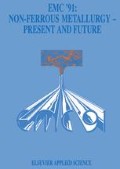Synopsis
In Europe 13 million cars are produced per annum which will end their economic life cycle with an average age of 10 years. The processing of scrap cars starts with size reduction by a hammermill, or shredder. After size reduction the magnetic fraction is removed by a magnetic separator. The remaining non-magnetic fraction is screened and each fraction is processed in a specific way, adapted to the particle size. In this way it is at present possible to recover metal values, at a high grade and recovery, and reject products with an acceptable contamination level for the environment.
The increased use of plastic, complex and composite materials in the automotive industry will have a negative effect on the recovery of metals and waste production from car scrap unless technology and design for recovery are improved. For the disposal of different waste products new quality control equipment has to be designed to meet environmental standards.
Access this chapter
Tax calculation will be finalised at checkout
Purchases are for personal use only
Preview
Unable to display preview. Download preview PDF.
References
Voigt B. NE-Metalle im Automobilbau. Metall. 42, Jahrgang Heft 3, März 1988.
Nijkerk A.A. Hoeveel auto’s vrij voor de sloop? Magazine Recycling Benelux. 24e jaargang nr. 3, juni /juli 1990.
Kola R. The processing of steelworks waste. Lead zinc go. The Minerals. Metals and Materials Society 1990.
Julius, J. Rückgewinnung von Nichteisenmetallen in Shredderanlagen durch trockensortierung. Metall 38 Jahrgang Heft 8, August 1984.
Dean K.C., Sterner J.W., Shirts M.B., Froisland, L.J. Bureau of mines research on recycling scrapped automobiles. United States Department of the Interior Bureau of Mines. Bulletin 684, 1985.
Dalmyn W.L., Voskuyl W.P.H., Roorda H.J. Recovery of aluminium alloys from shredded automobiles.
Dalmyn W.L., Dreissen H.H., Roorda H.J., Basten A.T. Mechanical separations of non-ferrous metals by means of gravity concentration and eddy-currents.
Personal communication with Mr. W. Ott of S + S, Schönberg, Germany.
Sattler H.P. Automatic sorting of non-ferrous metals from automobile shredders. Proceedings Recycling of non-ferrous metals, Williamsburg 1990, AIME meeting.
10. Witteveen H.J., Dalmyn, W.L. Concentratie van niet-ijzer metalen uit autoschroot. De Ingenieur nr. 3, March 1989.
Weiss K.J., Auer R.Fr., Dalmyn W.L. Selektives Abtrennen verschiedener NE-Metalle aus Gemengen. Metall, 36. Jahrgang Heft 4, April 1982.
Author information
Authors and Affiliations
Rights and permissions
Copyright information
© 1991 Institution of Mining and Metallurgy
About this chapter
Cite this chapter
Dalmijn, W.L., van Houwelingen, J.A. (1991). Car scrap recycling towards 2000. In: EMC ’91: Non-Ferrous Metallurgy—Present and Future. Springer, Dordrecht. https://doi.org/10.1007/978-94-011-3684-6_27
Download citation
DOI: https://doi.org/10.1007/978-94-011-3684-6_27
Publisher Name: Springer, Dordrecht
Print ISBN: 978-1-85166-715-4
Online ISBN: 978-94-011-3684-6
eBook Packages: Springer Book Archive

